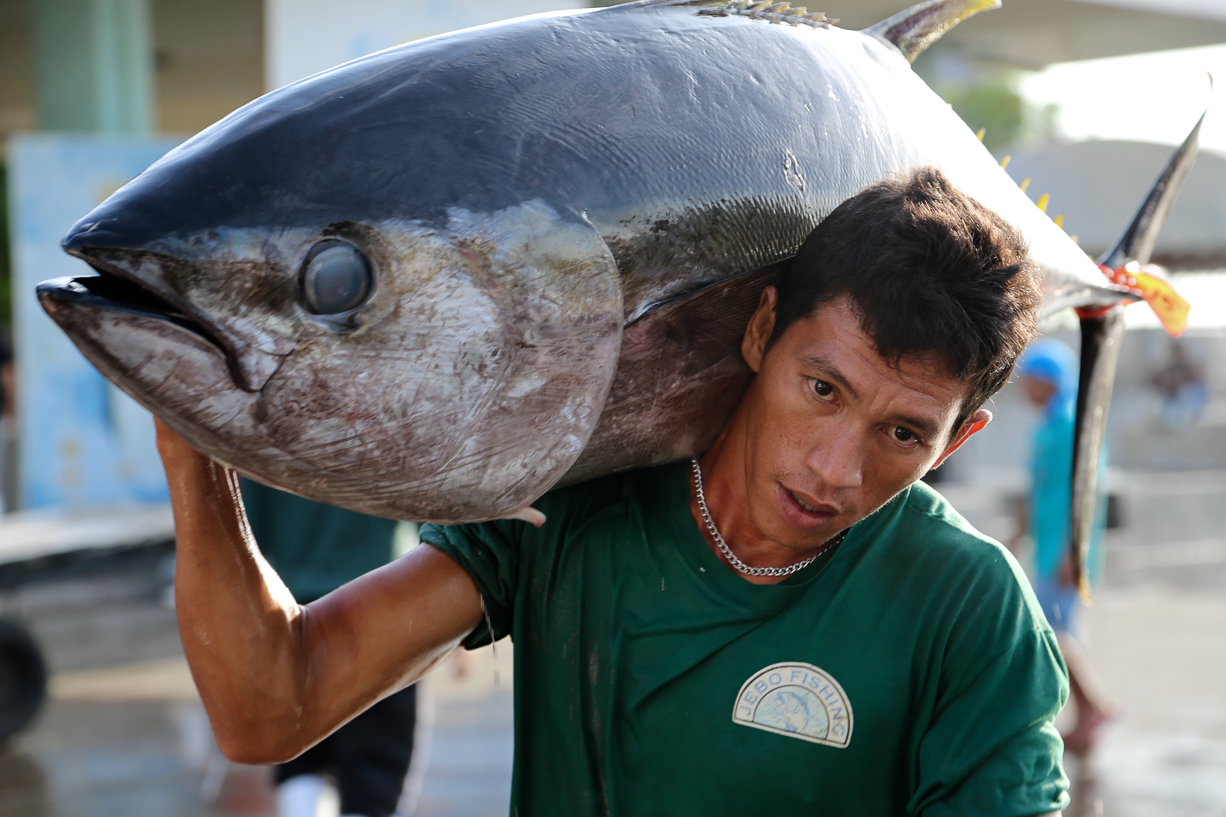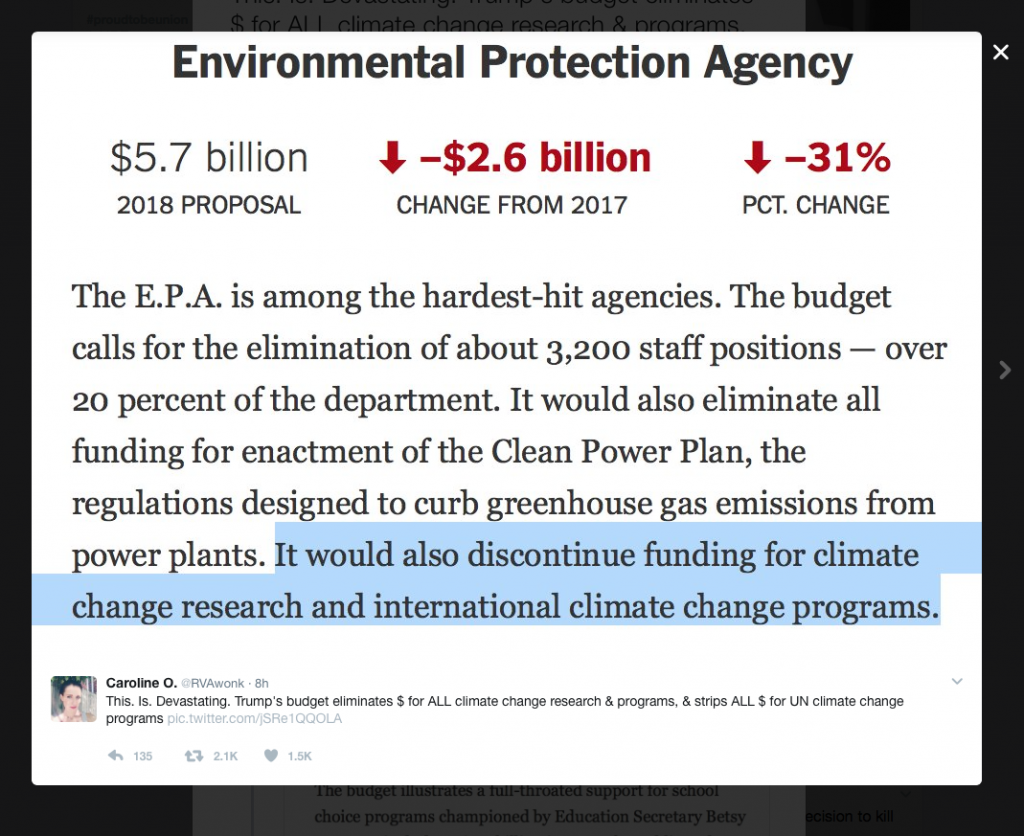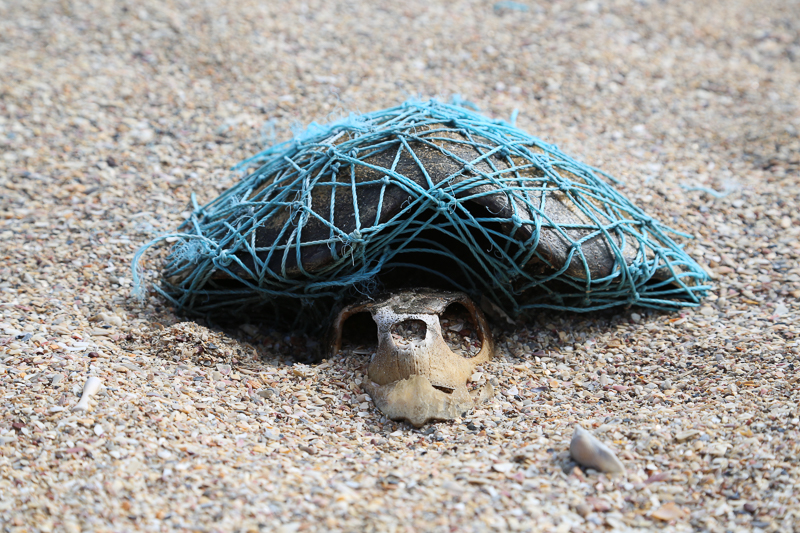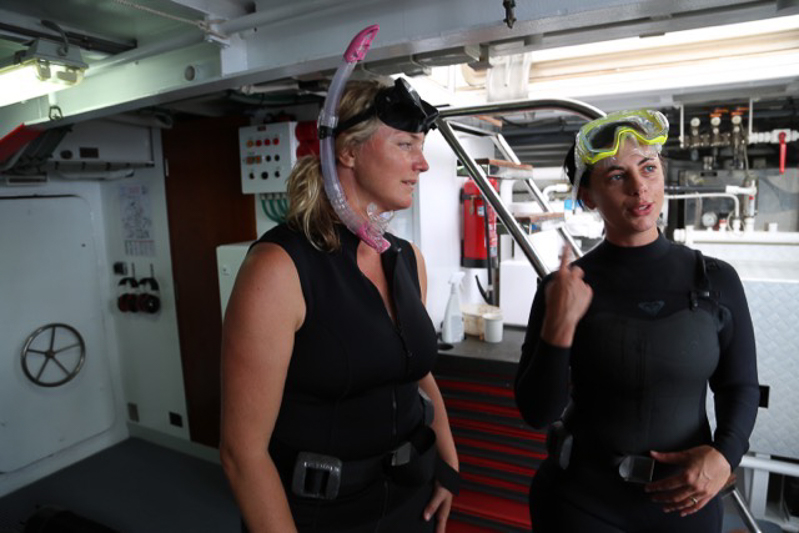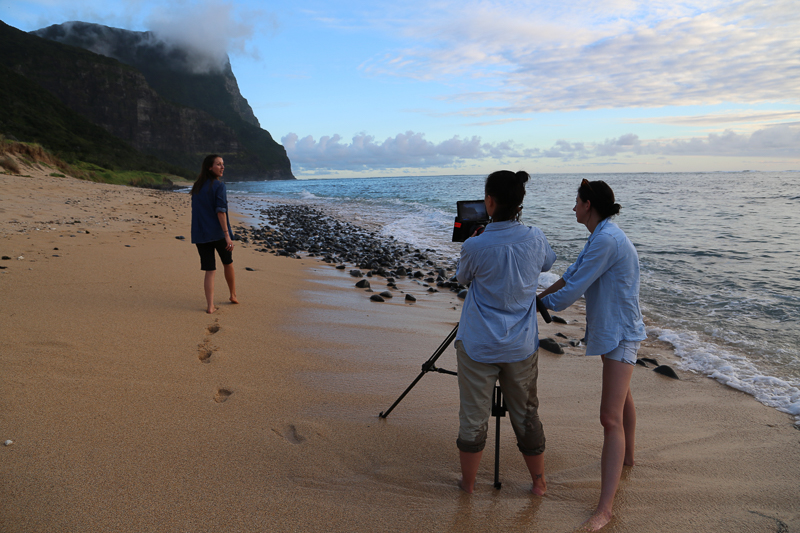My first interview with Karina Holden took place before she made Blue; this conversation a year later, when she had completed the film. Here, we talk about: how philanthropic funding made the film happen (HOORAY); the biggest environmental threat to Australia right now—the proposed Adani Mine in Queensland (BE AFRAID); how hard it was to get Australian celebrities on board a television show about the Great Barrier Reef (BOO), and why it’s not too late to act (don’t kick back any time soon, we have to act NOW).
Introduction
It’s been a hair-pulling and deeply disturbing news week for those who care about planet earth. The New York Times led with a front page story headlined: “Large Sections of the Barrier Reef are Now Dead, Scientists Find”. And the culprit is human society burning fossil fuels. It’s been going on for way too long… We’re way past the danger warning zone. The bleaching and death of coral reefs evidences the damage that in turn can lead to humanitarian crises. Forty-six scientists authored an article published in Nature titled Global Warming and Recurrent Mass Bleaching of Corals, stating that the destruction to reefs worldwide is caused by global warming—specifically underwater heatwaves. It couldn’t be more clear that the survival of the Great Barrier Reef depends on reducing emissions created by the burning of coal.
And then this: President Donald Trump wants to cut ALL funding to climate change research programs and partnerships:
We’re not spending money on that any more. We consider that to be a waste of your money.”
Meanwhile, in our own backyard, the Federal Government and State Government of Queensland are pressing ahead with Adani’s Carmichael Mine Project and the Abbot Point expansion which will produce 2.3 billion tonnes of thermal coal over 60 years and release 4.7 billion tonnes of carbon pollution into the atmosphere. Most of the exported coal will be shipped to India. It’s possible, if the Adani’s cannot raise the money from the private sector, that $1 billion in loans (i.e. tax payers money) will be provided under the federal government’s Northern Australian Infrastructure Facility to construct the rail line from the mine to Abbot Point port.
Late last week, Australian businessman and environmentalist Geoffrey Cousins travelled to India, to hand-deliver a letter to Mr Adani (Chairman and owner of the eponymous mining company), asking that he abandon plans for the Carmichael mine. The damage to the environment, the pollution the burning of coal would create, the health risks and impact on the Great Barrier Reef would be disastrous. The letter also urges Mr Adani to consider investing in renewables in Australia. Previously, Mr Cousins has remarked that building more coal mines makes little economic sense given the Indian Government is looking to renewables in the future, not coal. The letter is aimed at familial and national anxiety about the reputational damage which would result if the mine goes ahead. It is signed by cricketing legends Ian and Greg Chappell, writers Richard Flanagan and Helen Garner, former Australian of the Year Fiona Stanley, Telstra Chair John Mullen, investment banker Mark Burrows, among many notable others.
In his capacity as President of the Australian Conservation Foundation (ACF), Geoffrey Cousins was on the Blue table at Good Pitch 2015 when the film secured a very generous level of philanthropic support. He made everyone laugh when he said that being in a room where there was so much positivity and possibility “makes every hair on the top of my head stand up”. (He has no hair on the top of his head). In the same year, the ACF lodged papers in the Federal Court in Brisbane arguing that Environment Minister Greg Hunt failed to consider the impact of climate pollution from burning coal on the Great Barrier Reef, in breach of Australia’s international obligations. They are back in court while Premier Palaszczuk visits India to drum up support for the mine (and in the same week the letter was delivered by Mr Cousins).
As this post went live, the latest news following Premier Palasczuk’s trip to India, is that the Adani Carmichael mine is one step closer. Mr Adani is confident Federal approvals will happen as early as May-June and work will start on the mine in August this year. He described the open letter delivered by Geoffrey Cousins as “a motivated attempt by a very small group of 76 misled people.” Adani is also claiming they have the approval of the traditional owners the Wangan and Jagalingou (W&J) community. The anti-Adani group of W&J claims the “sham meeting” where the “decision” took place was funded by Adani. Moreover, they said they will challenge Adani’s “phoney” land use deal in the Federal Court.
Ms. Palaszczuk remarked that the signatories on the letter “have good jobs. I know how tough the people are doing in my state.” Maybe she should talk to the fisherman in India who warned Australia against proceeding with the mine. These were people who had directly experienced living by a local Adani mine and claim the mine killed off sea life and detrimentally affected their health and capacity to earn a living. They had to move from the area.
The Adani project is harming us. Their coal dust and stream discharge are harming us,” Mr Mohammad said, adding he now caught a quarter of what he used to.
“There are no fish in the sea water near the coast. All living creatures are dead.
The Chat
PJB: When we first got together all those months ago, you hadn’t started shooting Blue. How does it feel to have finished the film?
KH: I’ve just come from the editing room and I can’t think straight; I’m feeling… weirdly… emotional.
PJB: It would be weird if you didn’t feel that way. It’s normal when you’ve been through that intense finishing off process on a film… But it’s also the subject matter of Blue… I know it put a rocket up me. I was jangled and wanted to give over my life immediately to doing something, anything. No matter how hard I try to not feel panicked—I do and I don’t think that’s irrational… It’s a small thing but I was so affected by the footage shot by Ron and Valerie Taylor in the ’60s and ’70s (of the Great Barrier Reef) because the abundant life and colour isn’t there anymore. I love that film documents what isn’t here but paradoxically, it brought the loss to life. I felt grief and shame for Australia…
There’s a feeling in some quarters that it’s too late to stop the greying of the ocean, too late to respond to climate change, too late to save the Great Barrier Reef, too late to save the forests and species at risk of extinction. Do you think it’s too late or can we turn it around?
KH: Spending time with people who are involved in these issues, they say: Even if you think or are told the battle is lost, you don’t give up… Seeing their persistence and their courage, and the steps they are taking inspires me. I believe humanity will innovate and adapt to find solutions but we need to understand that with every choice we make, there is a chain reaction—create less waste, don’t eat fish all the time, read the labels, don’t use plastic bags—these seemingly small things can make a critical difference. We have a huge impact on the planet and other species — the fact that that is seen as an option, instead of understanding that other species are sentient beings that have a right and a reason to be here… and more than that…
This is the fabric of life; everything is inter-linked. You start to pull the threads and lose, for example, wasps or bees or birds that fertilise plants, that create the life that hold the sand together to form islands… All those things I have tried to bring into the film so we human beings see ourselves as part of nature not separate from it; it’s who we are. Everything has its place in the world and a reason for being—other creatures don’t need to build space ships to be relevant.
PJB: I can’t help thinking about the climate change scientists in the US who when Donald Trump was elected, started copying all the climate change data because they were/are terrified that it’s going to be deleted… Blue couldn’t be more timely. More than ever, we need scientists making films about how the world is, not the selective view that reinforces the delusion that all is perfect.
KH: The stakes are high right now. I accept that there are people in the world who have different politics and religious and cultural beliefs—
PJB: And commercial interests—
KH: Yes… but when it comes to people’s position on the environment, my heart just breaks that they cannot see the importance of making the environment a priority. Decisions by leaders in one country have massive impact on other people in other countries.
PJB: Some things like nature are truly beyond, or should be beyond politics, religion, commerce and culture — all human–made, of course.
KH: We take the ocean for granted. The ocean is 70% of the planet, 97% of all living space on earth is contained within it and yet it’s a backdrop for human consumption and commercial priorities, it’s not given its primary place.
PJB: What do you see as the most pressing environmental issue for Australia at this time?
KH: What’s going to happen with the proposed Carmichael mine in the Galillee Basin in Northern Queensland. As soon as the government uses our tax payers money to fund that billion infrastructure project to allow coal to be taken out of the earth: the process of digging it up, the process of dredging the harbour… allowing the industrialisation of the coast line, allowing that coal to be burnt.
Where is our commitment to meeting our carbon targets? Not there because we’re allowing all that dirty coal to be burned in developing countries and we’re allowing development on our coastline. It’s a tragedy to allow that to happen.
People have fought for years and years and years. That project has been overturned, and then it’s back on, it’s over turned and then it’s back on… politicians want to create jobs for Queenslanders and they are using our tax payers money to build something that will impact negatively on the Great Barrier Reef which is already in such trouble.
PJB: I remember the pitch weekend prior to the big day (Good Pitch) when Geralyn Dreyfous (Oscar-winning US producer) was saying: “It’s not just a problem for Australia, it’s a problem for the whole world…the Great Barrier Reef is loved and belongs to all of us.” And yet, it belongs to none of us. We are caretakers only, and dismally failing in our responsibility to look after it.
KH: It’s seen as a tourist attraction. But the Great Barrier Reef is not a luxury or a place that exists for our pleasure; it’s a critical marine habitat that once gone, will have a massive impact… the amount of carbon that is stored in mangrove systems, in our sea grasses, the protection our coastline gets from those coral reefs… once it’s just rubble and slime, it can’t support life—two thirds of all creatures on the planet have their life cycle in a coral reef. The Great Barrier Reef supports the whales that come to breed there, that then go down to Antarctica; it’s where the tuna spawns—the babies grow up in the reef and feed the people of the northern and central pacific.
We are a developed nation with a low population and the science, will and ability to protect it ourselves… The amount of good we are doing to the rest of the world! (which is why it is world heritage protected)… To protect coal mining? It’s a tragedy
PJB: And a travesty. Why don’t politicians spend our tax money investing in research and industries that will carry us through this century— sustainable jobs and caring for the environment we can’t live without. One priority doesn’t have to be sacrificed for the other. They are not mutually exclusive but it takes planning and investment. I digress…
I loved watching Blue in a cinema because I was immersed—under water, above water. It brings up a lot of complex feelings this film—I didn’t just absorb it as devastating fact, it has narrative emotional power.
KH: That’s why I was so happy that I could make it in that format; I’m breaking all the rules that would apply to television. I know if I had to make it for television and impose a specific format on it—it wouldn’t work, because we had always wanted the audience to go from beginning to end, not switch or break, to witness but also for the audience to sit with how or what it makes them feel; to not be heavy handed in the language or messaging but invite people into an experience as well.
PJB: You’re very experienced making television shows but on Blue, obviously you wanted a style of shooting that worked in cinemas: the wide shots, the aerial shots, the pace, and feeling of emptiness in the ocean… Did you work with the DOP differently to how you usually do?
KH: I’ve shot a lot of marine footage for television and with Blue, the intention was to make it look very different from that. Jody Muston, the DOP does mainly drama—
PJB: Tell us what a natural history show typically looks like for television.
KH: It’s fast paced, super-saturated, there’s a lot of action and faster cutting; with Blue we shot in wide screen through out. Working with Jody, we came up with our colour palette, framing style and pace, and shot with Cooke prime lenses. We always story boarded before we went on location because we only had 30 days to shoot the whole film and we filmed in the Philippines, Hawaii, Indonesia, Cape York, the Great Barrier Reef and Lord Howe Island. We had several locations to juggle. And we always shot before 6 o’clock in the morning so there was a softness and consistency to the image. We didn’t want it to look like television and we wanted to elevate the image so the audience slowly becomes enraptured, even if what they are looking at is hard to look at. Jody really pushed me—she was a great influence and collaborator.
PJB: I say this as a compliment—I was surprised by how unprettied up it is. It’s cinematic in style and scope and truthful. There’s awe and horror but there’s also hope.
KH: I stretched myself and got to process things in new ways; I was learning a new grammar. And when we put our application in for Good Pitch, we hadn’t started shooting. I had an idea but it was unformed… I always felt an obligation to be collaborative. I was given the opportunity to have the CEO of Greenpeace International as one of our partners, the campaigners from the Pew Charitable Trust and the Australian Marine Conservation Fund (ACF)… With access to those great brains, I wanted to be open and take on ideas. The first six months was research and conversations, thinking about how to come to a place where I could serve all people—I know it’s impossible but I like to try.
PJB: How very woman-like of you….
KH: I know… What I’m trying to say is that it wasn’t about me, with the opportunities I’d been given through Good Pitch I wanted to take those conversations and maximise how they were used in the film.
PJB: I think it’s also because you are a scientist, you understand the issues, you care and are intellectually rigorous… You don’t have a romantic relationship with nature—
KH: I have a very romantic relationship with nature—
PJB: OK, but you understand how it works as a scientist, which many who have a romantic relationship with nature do not.
KH: I can put on two hats…
PJB: Let me try another tack: you were serving a bigger idea about how at risk the world is with the threat to the ocean, how it’s so much bigger than all of us regardless of our relationship with it.
KH: Yes, and as a program maker I’m not given the opportunity to make this kind of film because no-one is paying for, committing to or distributing this kind of content.
Unless you are Leonardo Di Caprio or Al Gore then what chance do you have of making a conservation film or a film with an environmental message at its core? There’s been a couple of breakthroughs but they’ve been in the theatrical space and those risks haven’t really been taken in Australia.
PJB: How hard is it to raise funds for films in Australia with an environmental focus?
KH: Very hard. We have $100,000 from Screen Australia and happy to have it but it’s not a lot compared to what goes to other projects that have an ephemeral life and aren’t tackling something as fundamental as what I believe Blue is about.
PJB: Personally, I think that’s shocking, short-sighted and dumb. We’ve never needed more great stories and programs about the environment, science and natural history and there’s never been less made or supported by our public broadcaster. It takes me back to our conversation about shutting down the ABC’s Natural History unit... We need too get ahead of the curve, not slide further backwards and at pace.
KH: So you see why I say we were very lucky to have Good Pitch supporting us, and the philanthropic funders or we couldn’t have made this film; we’d barely have had investment out of Australia…
When (Northern Pictures) was making Life on the Reef, about the Great Barrier Reef, we were trying to find Australian celebrities who were into the environment and would make their fee accessible to a television documentary and it was not happening. Everyone wanted to use their SAG agreements and use their US attorneys.
PJB: I want to use several expletives but I’ll settle for a non-expletive like DISAPPOINTED.
KH: Yeah and we don’t have the celebrities speaking out about the environment, like Leonardo Di Caprio, let alone funding. So far, it’s not a part of our culture here in Australia.
PJB: Well, they’re going to have get on board aren’t they?
KH: There is a real opportunity there. There’s good people funding projects—you know some of them, I know some of them but there is definitely space for more.
PJB: I think it’s also wrong and astoundingly dim that the environment has become a political issue. It should be a bi-partisan movement to do what is best for the future of the planet. It’s the problem with territorial thinking of all kinds.
KH: When the plan was first drawn up for Marine Parks around Australia, protecting hundreds of thousands of kilometres of coastline, the support was bi-partisan. It was done by the Howard Government with bi-partisan approval and then, when Tony Abbott was Prime Minister he had it taken off the table for review and it has sat there ever since.
Nothing has happened.
It was ten years of drafting leading up to that proposal, there was a lot of smart people doing a lot of work, getting a lot of support. It’s such a massive shame… I’m hoping in 2017 there will be some wins and announce some Marine Parks… the Ross Sea Marine Park — that’s a huge win. When we’re dealing with so much bad news, when those wins happens we’ve got to keep putting them at the forefront of the messaging: it’s possible, it does happen, it’s not out of reach.
Marine Parks and Sanctuaries are a huge part of ocean conservation because it’s about creating zones in the ocean that protect not only that specific place but the fish that come into breed and that clean, healthy environment supplies food. When there is climate change and global change in the ocean—those sanctuaries can re-seed the parts of the ocean that are suffering. Sylvia Earle calls them ‘hope spots’, the pulse for the rest of the ocean.
PJB: It’s as if we need global policy trackers and alerts that go out whenever politicians reverse or shelve climate change or environmental policy and make a lot of noise about the consequences… and it is about mobilising public opinion…There is an elder in your film but the majority of the activists are Gen Y. For decades scientists and activists have worked tirelessly and invisibly, why did you choose to focus on Gen Y?
KH: It’s about all generations collaborating and being active but the Y Generation are being confronted with these critically important issues now and they want to see action and change… They say, This is not OK, I’m going to do something and they are doing incredibly brave things and being outspoken… There’s a lot of heartbreak among people who have been fighting for change, for decades, and these young people bring energy and hope…
PJB: That makes sense.
KH: I hope Blue inspires people to act and drive decisions about what’s best for the marine environment because this won’t wait.
Blue releases theatrically later this year.
All photos re-printed here supplied courtesy of Northern Pictures.
Tags: Adani Carmichael Mine, Australian Conservation Fund, climate change, Great Barrier Reef, Greenpeace, Karina Holden